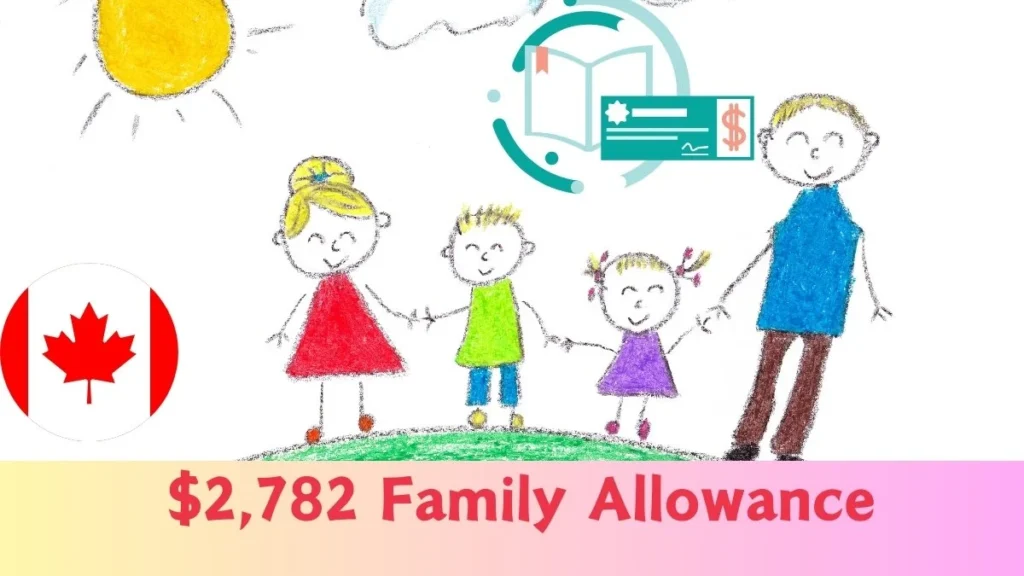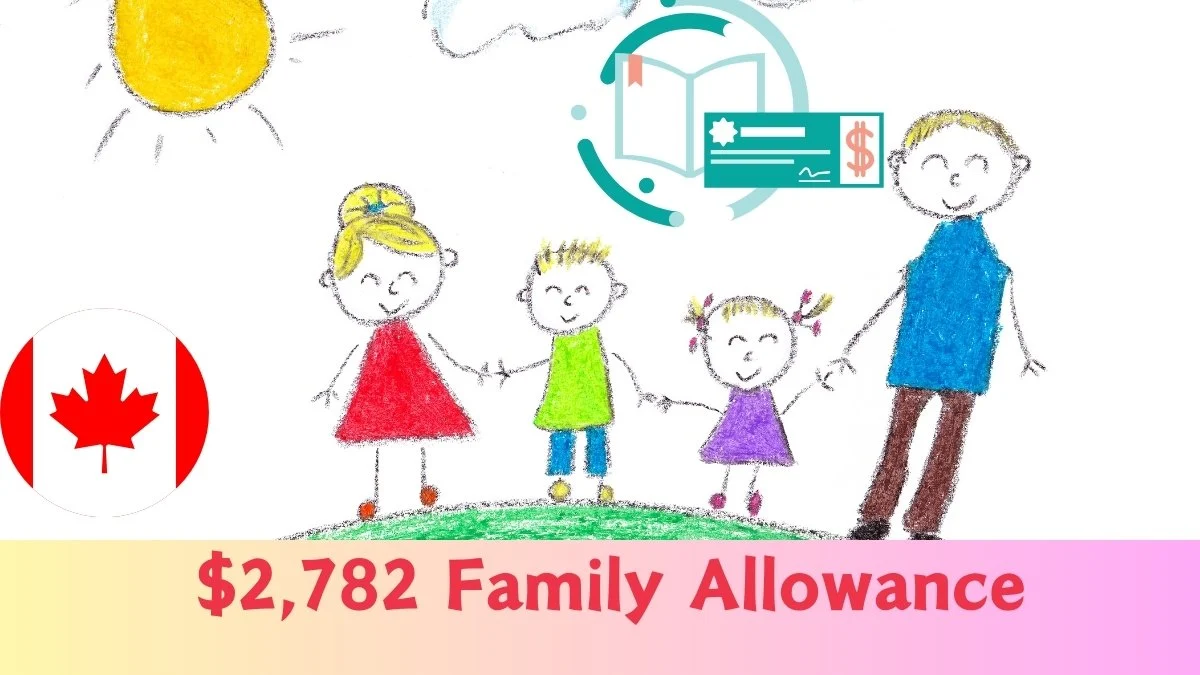$2,782 Family Allowance in Canada:Canada is committed to supporting families, and a significant component of this commitment is the Canada Child Benefit (CCB). Designed to provide financial assistance to families with children under 18, the CCB has a maximum annual amount of $7,437 per child, with the actual benefit varying based on family income and the number of children.

It’s essential to clarify that there isn’t a separate $2,782 Family Allowance program. This figure likely corresponds to the maximum annual CCB benefit for one child. Looking ahead, the Canadian government has plans to enhance CCB benefits for children under 6 years old, with an expected increase of around $1,200 per year starting in July 2024.
Beyond the CCB, various family support initiatives contribute to the well-being of Canadian households. These include programs like Canada Worker Benefits, offering tax-free benefits to low- and middle-income workers, the Canada Housing Benefit aiding low-income renters with housing costs, and Canada Dental Benefits, providing dental care coverage for children under 12 from low-income families
Overview of Family Allowance:
Recent discussions surrounding a potential $2,782 increase in the Canada Family Allowance have captured the attention of many Canadian families and ignited lively debate. While this figure has sparked speculation and hope, it’s crucial to approach this topic with a critical lens, delving beyond the headlines to analyze the potential implications and navigate the complexities involved.
Is it official? It’s important to clarify that the $2,782 figure stems from various proposals and discussions regarding Family Allowance modernization. No formal announcement has been made by the government, and the path forward remains contingent on several factors, including:
- Parliamentary approval: Implementing significant program changes requires parliamentary approval, a process demanding careful consideration and potential amendments.
- Economic considerations: The final decision will hinge on prevailing economic conditions, budgetary priorities, and political consensus.
- Program design: Effective implementation necessitates a well-designed program that ensures fiscal sustainability and equitable distribution of resources.
Examining the potential impact: While the potential benefits of a substantial increase are undeniable, it’s crucial to acknowledge the challenges and complexities involved:
- Financial security: A significant increase could significantly enhance the financial stability of low-income families, fostering greater flexibility and potentially alleviating financial strain.
- Child well-being: Increased funding could translate into improved access to crucial resources like healthcare, education, and extracurricular activities for children, potentially fostering their development.
- Economic stimulation: Injecting additional funds into families can stimulate the economy through increased spending, potentially benefiting local businesses and creating jobs.
Challenges and considerations: Alongside the potential benefits, we must also acknowledge the challenges:
- Fiscal sustainability: Balancing the potential benefits with responsible fiscal management and ensuring program sustainability is paramount.
- Targeted allocation: Reaching families most in need and distributing funds equitably requires careful consideration and program design to avoid unintended consequences.
- Holistic approach: Potential changes to the Family Allowance should be integrated with other social programs to create a comprehensive and cohesive support system for Canadian families.
Overview of Family Allowance in Canada:
| Program | Description | Eligibility | Amount | Frequency | Notes |
|---|---|---|---|---|---|
| Canada Child Benefit | Tax-free monthly credit for families with children under 18 | Children registered under RC66 form, CRA My Account required | Up to $7,437 per child | Monthly | Varies by province based on living costs |
| Canada Worker Benefits (Advanced Canada Worker Plan) | Security benefits for tax-paying employees | Annual income under $90,000 | Up to $15,180 (doubled in 2024) | Yearly | Replaces previous Canada Worker Benefit |
| Canada Dental Benefits | Dental care support for families earning under $90,000 with children under 12 | Children under 12 | N/A | N/A | New program launching in 2024 |
| Canada Pension Plan (CPP) | Security deposit and income for seniors over 65 | Net worth under $40,000, at least one employment contribution | Up to $1,839 deposit, income based on contributions | Monthly | Additional Old Age Security (OAS) available for eligible seniors |
| GST/HST Credit | Credit for personal and business purchases | Varies based on income | $450-$650 | Quarterly | Lower income families receive higher credit |
| Tuition Tax Credit | Tax credit for student tuition fees | Students completing T2202 form | Up to $6,000 | Annually | Helps manage education expenses |
Additional points to consider:
- The $2,782 Family Allowance mentioned in the original text is not a separate program, but likely refers to the maximum amount that can be received per child under the Canada Child Benefit.
- Provincial variations may exist for some programs, so be sure to check with your provincial government for specific details.
- Some programs are still under development or not yet fully implemented
Who is Eligible for $2,782 Family Allowance?
The $2,782 Family Allowance program in Canada provides financial support to eligible families with children under the age of 18. To ensure responsible allocation of these funds, specific eligibility criteria have been established. Here’s a concise and professional breakdown of who qualifies:
Essential criteria:
- Canadian residency: All family members must have been resident in Canada for a minimum of 10 consecutive years.
- Tax compliance: The family must be registered with the Canada Revenue Agency (CRA) and have filed the required RC66 form. Additionally, all outstanding taxes owed to the CRA must be settled before applying for the Family Allowance.
- Child Benefit Plan registration: Families with children under 18 must be registered for the Child Benefit Plan.
Family composition considerations:
- Seniors: Families with senior members receiving Canada Pension Plan (CPP) benefits are eligible.
- Separated parents: In cases of separation, each parent’s household may be eligible for half of the child’s benefits, provided they meet the individual criteria.
Additional points:
- Income: While there is no absolute income cut-off, the amount of Family Allowance received may be adjusted based on the family’s total income.
- Indian Act registrants: Individuals registered under the Indian Act are also eligible for the Family Allowance program
Provincial Variations in the $2,782 Family Allowance Program:
While the $2,782 Family Allowance is a federal initiative, it’s important to note that provinces have a degree of autonomy in its implementation. This results in nuanced variations in eligibility criteria, payment amounts, and administrative procedures.
Key Considerations:
- National Framework, Provincial Discretion: The federal government establishes the overall framework for the program, but provinces can tailor certain aspects to align with their unique needs and priorities.
- Potential for Additional Benefits: Some provinces augment the federal Family Allowance with supplementary programs, offering further financial support to families.
- Factors Influencing Precise Amounts: The specific amount received by a family is contingent upon family size, income level, and the specific regulations of their province of residence.
Illustrative Examples:
| Province | Family Allowance Program |
|---|---|
| Alberta | $1,330 per child Family Allowance + $1,379 security deposit (quarterly) |
| Ontario | Independent Family Allowance program with unique criteria and structures |
| Quebec | Distinct system of credits for families with children |
| Nova Scotia | Family and Child Benefits under specific guidelines |
| Yukon | Child Benefit program specifically designed for residents |
| New Brunswick | Child Benefit Plan with own regulations |
VISIT USAOFFBEAT HOMEPAGE FOR LATEST INFORMATION
